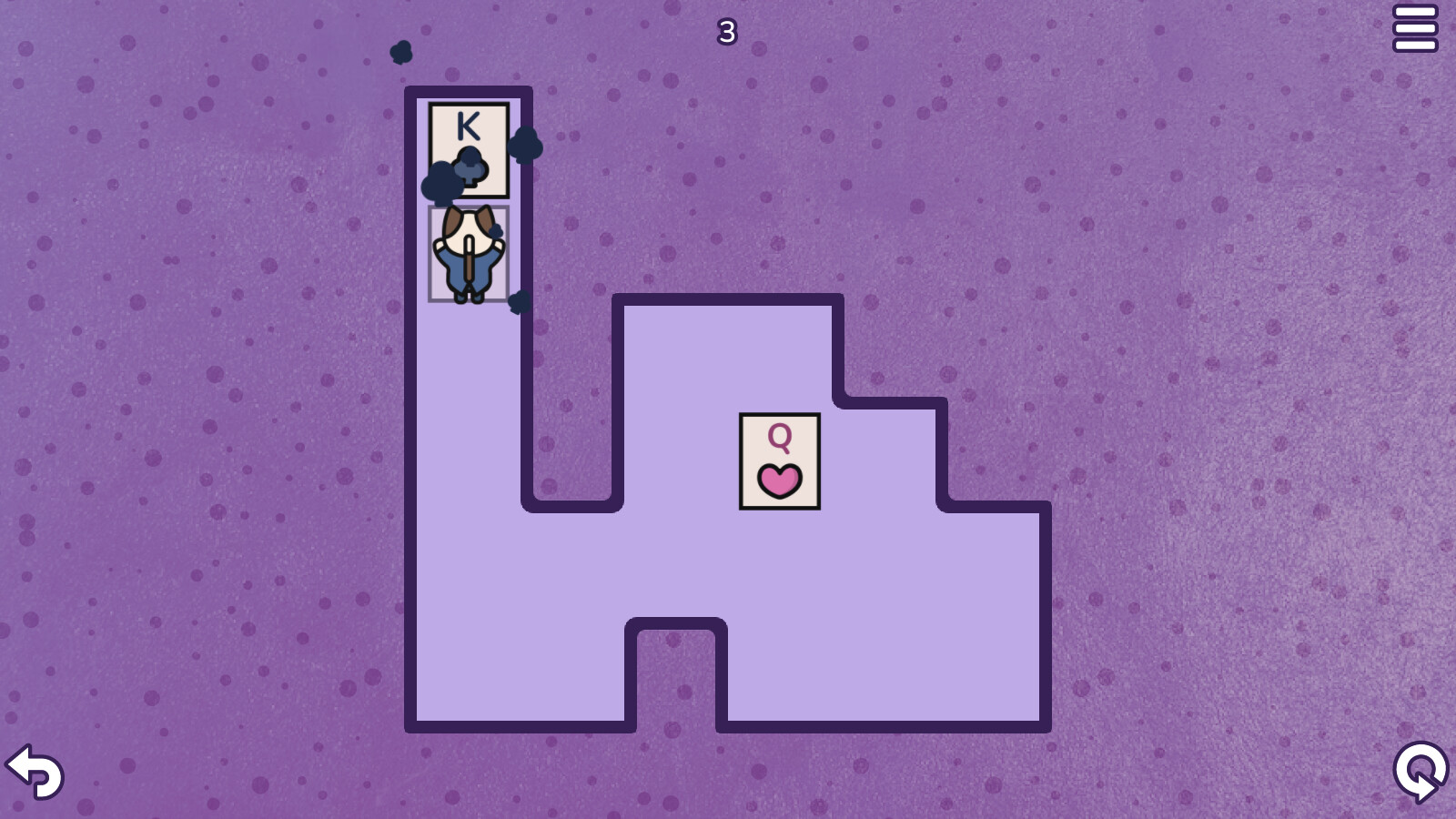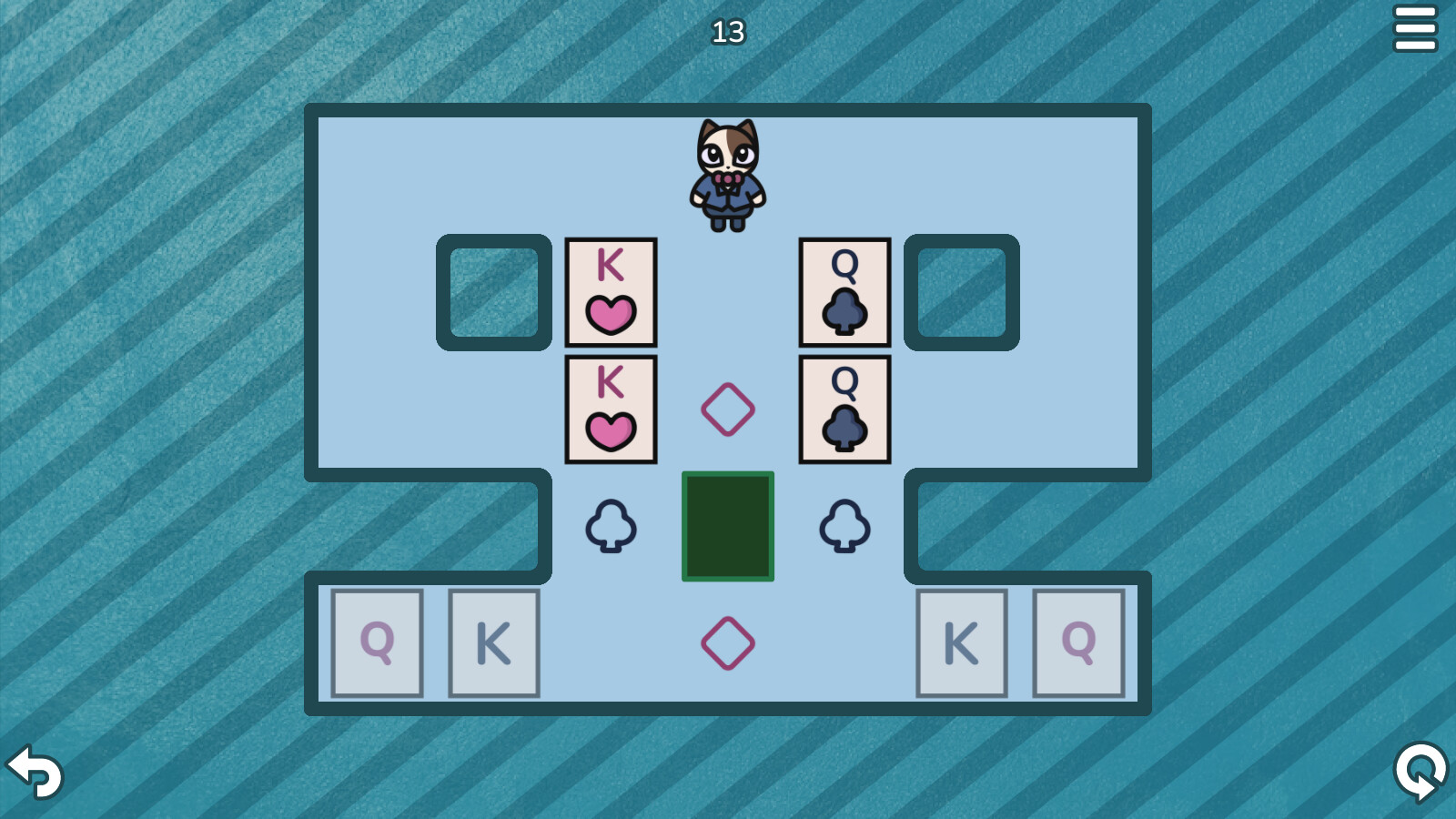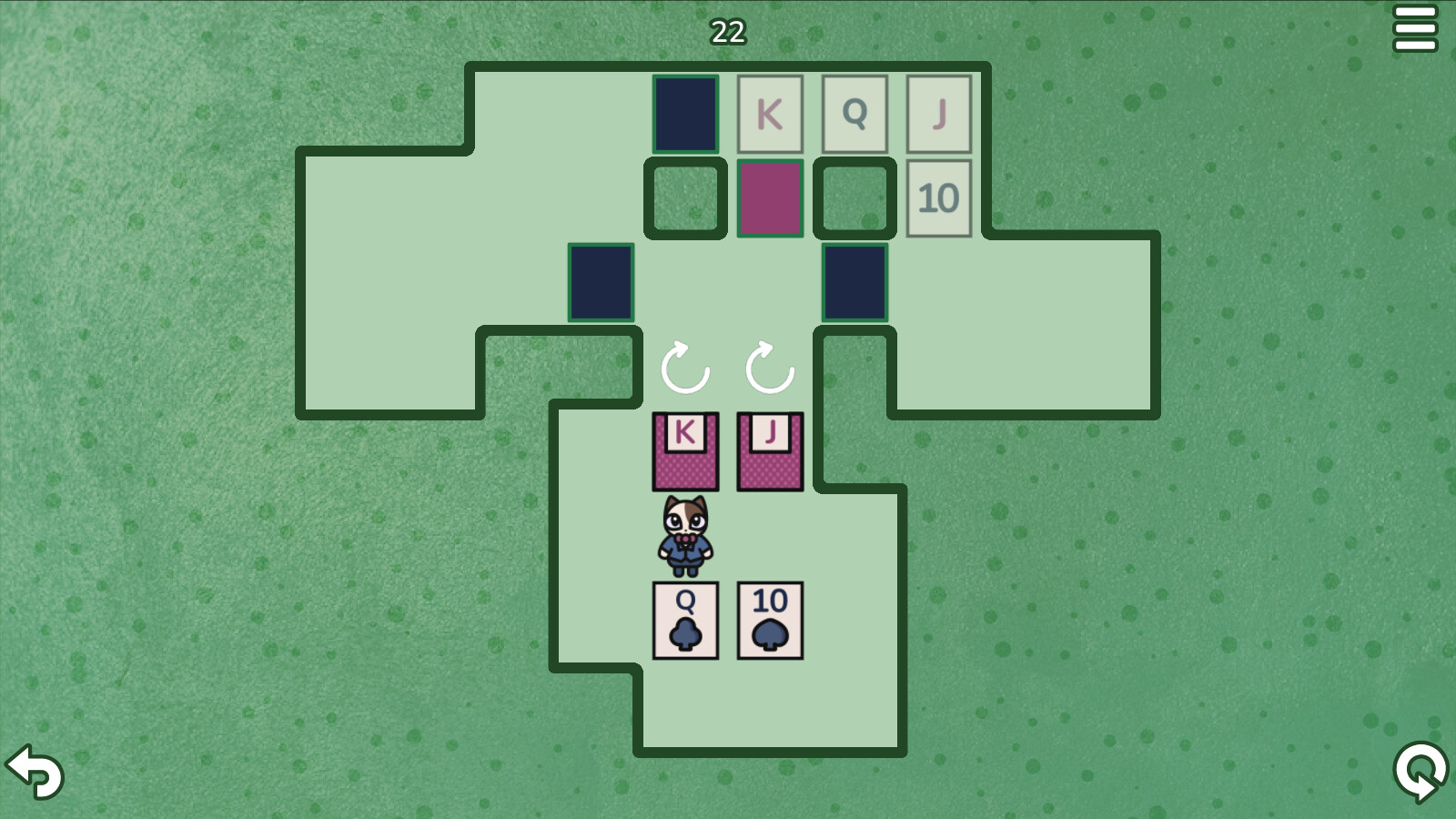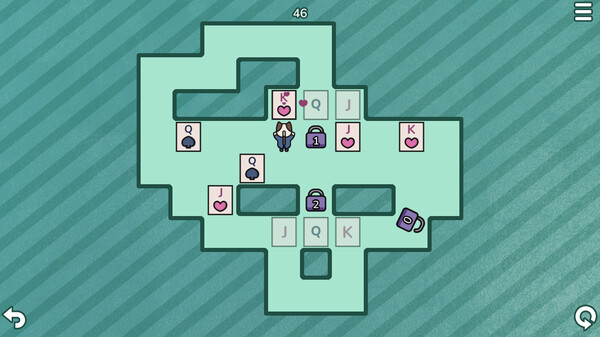What is SokoSolitaire?
SokoSolitaire is a unique game combining the block-pushing Sokoban formula with Solitaire elements. Use your wits to navigate each level by pushing cards to their destination while stacking or flipping them along the way if necessary.
Push the cards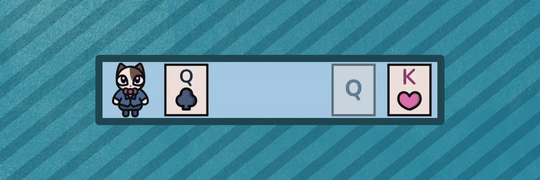
The goal of each level is to push all the cards to their destination.
Inspired by Solitaire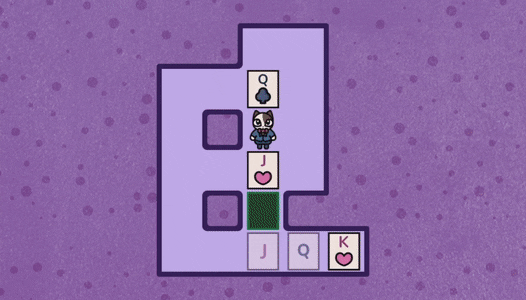
Overcome unique Solitaire inspired elements unseen in other puzzle games.
Stack your cards, flip them around, change their suit and more!

SokoSolitaire is a unique game combining the block-pushing Sokoban formula with Solitaire elements. Use your wits to navigate each level by pushing cards to their destination while stacking or flipping them along the way if necessary.
Push the cards

The goal of each level is to push all the cards to their destination.
Inspired by Solitaire

Overcome unique Solitaire inspired elements unseen in other puzzle games.
Stack your cards, flip them around, change their suit and more!

- 60 handcrafted levels
- Infinite undos
- Don't like a level you are playing? Skip it!
- Innovative and fresh combination of Sokoban and Solitaire.
- Colorblind mode - Trichromatic, Dichromatic and Monochromatic options.
Devlog 3#

A piece of advice I heard somewhere, sometime ago I really like goes along the lines of "Assume your game is the player's first videogame they have ever played.", no matter what the player does here, they cannot get stuck. They will always be able to solve the level. The player just has to go right, then move up which will also push the card to its destination eventually. Even if the player doesn't figure out what the transparent outline of the card is just by looking at it, once the card is pushed there and the level finishes, it will become clear to them.
The more games I make, the more I enjoy the idea of letting player figure things out, rather than telling them. In Sokobos there's a tutorial window pop-up at first level that tells you how to move and what you need to do to solve the level.

Many people told me they didn't read it and just closed it. Then they figured out how to control and play the game anyway. Turns out a see-through outline of a statue and 4 pieces of the said statue are pretty self explanatory. Although you can actually fail in this level as you can push the parts in a way the level becomes unsolvable and then you have to undo a few steps or restart.

In SokoChess and SokoChess White I wanted the tutorial to be less intrusive, so I figured I'd just show the text on the side of the screen, highlight important words and let people read it, if they want to. As you can see, I still explain what the goal of the level is, even though again, just by looking at it you can very easily figure it out, not to mention there is no way you can get stuck in this level.

Most tutorial levels are easy to make. They are very straightforward and short, since limiting the movement space is how you can easily direct the player towards what you want them to do. Funnily enough level 6 was the hardest and longest tutorial level to make for SokoSolitaire due to the card stacking mechanic. It just took a while to get it where I really liked it.
Quick refresher in case you forgot, the green field allows you to stack cards on top of each other. It goes from the lower rank to higher, so if you push a Queen there, only a King can go on top of it. I wanted to make sure this is something the player really understands. This is why the player starts above the Queen and the only way to progress through the level is to push the Queen down, this also stacks it so it shows the player the interaction. On top of that it demonstrates the green field does not block cards. In order to push a card out, you move into it and the highest ranking card, in this case the King, comes out.

After the first move the player has a bit of a freedom, but it won't take too long until they figure out what to do next. The King is next to the Queen and the path to move to it, is open. In case the player tries to do something else, they will quickly realize that is not the correct thing to do. If they push the Queen down further, they can't push out the King. If they push the Queen to its destination, the King cannot be pushed to its anymore.

At first sight it may appear this level is just what the tutorials taught the player previously. You have to move the cards to their destination and there is a single card stacker, however there's much more going on.
Firstly, most of the cards are placed in a very inconvenient way. The cards destination create an unusual shape, it's not a horizontal or vertical line, it's a mix of both. Furthermore once you put a King in its place, the level's top area will not be traversable anymore. You have to figure in what order you need to push the cards to their destination, while joggling the cards around so you can access the card you need to move next.
I'm making the player do something they either haven't done before or like in this case, they have done some parts of it before but in an isolated manner. So before this level, there are levels where the player must juggle the cards around, so they can get the correct card out first. However in level 10, they must do multiple of these things at once.
Making a level like this always starts with an idea for a unique interaction or a combination of interactions. Then I sit down, I make the level layout and start placing the things down in Godot, of course it doesn't always go smoothly. Sometimes I figure out the idea in my head doesn't actually work, because there isn't enough space, so I have to adjust that. Afterwards I may find out there is a much more simple solution due to the previous changes which means the player doesn't need to do the new, interesting thing I want them to do, so I change it again. As you can see, there's often a lot of trial and error involved as well in this process.
As I mentioned before, all levels in SokoSolitaire are made using this and the previous tutorial method. Therefore you might wonder how I get enough ideas to make 60 whopping levels, or in case of the SokoChess games 70 per each game. Well, when you have as many mechanics as I do in SokoSolitaire it comes quite naturally. As you are programming mechanics or making levels, ideas just come to you naturally.
Last but not least, sometimes ideas come when you least expect them to. Sometimes I get them when I am showering, walking my dog or also when I am sitting on the toilet. Yes, the muse toilet is real, I can confirm her existence and I must say she's been very kind to me during my game making endeavours. I call her Poopelia.
Yep... A bit underwhelming, I know, but really sometimes I just make a random level layout, I put in bunch of objects and I try to make something out of via trial and error and then I refine it.
Funnily enough, these levels take the longest time to make, usually at least double if not more than with the previous method. They often end up being very difficult and they almost always feel unfocused. People often stare at them and have no idea where to even start. This is why many praised SokoChess White for having more focused levels. I used this method way less in that game than the original.


Here's two levels from SokoChess that were made using this method. There are some good ideas and interactions in there, but the levels are too large which results in the player having way too many options where to move and looking back I do admit it's needlessly difficult to solve. It's funny, no matter how much I refine a level made this way, it never compares to when I make a level from scratch based on an idea.
I hope you enjoyed this look into how I design levels for my puzzle games. Next time I'll put on my nerdy glasses (which I don't have, so I better go shopping soon) and I'll talk about how I program games and show you some of my code. Possible trigger warning, I'm a below average programmer, but I actually know how to get stuff done and finish games!
When it comes to making games my most favorite part is creating the actual content you play which in this case means making the levels. In this devlog I'll walk you through my 3 methods I use to make levels, although in case of SokoSolitaire I only used 2 of them, more on that later.
1) Teach the player
When I sit down to make a level, the first thing I do is ask myself what I want to accomplish with it. In case of these levels, it's to teach the player a basic rule or interaction of rules. Let's start with the most simple example, the very first level of SokoSolitaire.
A piece of advice I heard somewhere, sometime ago I really like goes along the lines of "Assume your game is the player's first videogame they have ever played.", no matter what the player does here, they cannot get stuck. They will always be able to solve the level. The player just has to go right, then move up which will also push the card to its destination eventually. Even if the player doesn't figure out what the transparent outline of the card is just by looking at it, once the card is pushed there and the level finishes, it will become clear to them.
The more games I make, the more I enjoy the idea of letting player figure things out, rather than telling them. In Sokobos there's a tutorial window pop-up at first level that tells you how to move and what you need to do to solve the level.

Many people told me they didn't read it and just closed it. Then they figured out how to control and play the game anyway. Turns out a see-through outline of a statue and 4 pieces of the said statue are pretty self explanatory. Although you can actually fail in this level as you can push the parts in a way the level becomes unsolvable and then you have to undo a few steps or restart.

In SokoChess and SokoChess White I wanted the tutorial to be less intrusive, so I figured I'd just show the text on the side of the screen, highlight important words and let people read it, if they want to. As you can see, I still explain what the goal of the level is, even though again, just by looking at it you can very easily figure it out, not to mention there is no way you can get stuck in this level.

Most tutorial levels are easy to make. They are very straightforward and short, since limiting the movement space is how you can easily direct the player towards what you want them to do. Funnily enough level 6 was the hardest and longest tutorial level to make for SokoSolitaire due to the card stacking mechanic. It just took a while to get it where I really liked it.
Quick refresher in case you forgot, the green field allows you to stack cards on top of each other. It goes from the lower rank to higher, so if you push a Queen there, only a King can go on top of it. I wanted to make sure this is something the player really understands. This is why the player starts above the Queen and the only way to progress through the level is to push the Queen down, this also stacks it so it shows the player the interaction. On top of that it demonstrates the green field does not block cards. In order to push a card out, you move into it and the highest ranking card, in this case the King, comes out.

After the first move the player has a bit of a freedom, but it won't take too long until they figure out what to do next. The King is next to the Queen and the path to move to it, is open. In case the player tries to do something else, they will quickly realize that is not the correct thing to do. If they push the Queen down further, they can't push out the King. If they push the Queen to its destination, the King cannot be pushed to its anymore.
2) First there was an idea, then there was a level
What I always want to avoid is making a filler level, which to me is a level that brings nothing new to the table. One could say these levels still teach you something, but I like to think of it as letting a player figure out a puzzle that requires them to do something before unseen that they can now realize how to do based on what they were previously shown and taught. It makes for a great "A-ha!" moment which to me is what makes a puzzle memorable and often great.
At first sight it may appear this level is just what the tutorials taught the player previously. You have to move the cards to their destination and there is a single card stacker, however there's much more going on.
Firstly, most of the cards are placed in a very inconvenient way. The cards destination create an unusual shape, it's not a horizontal or vertical line, it's a mix of both. Furthermore once you put a King in its place, the level's top area will not be traversable anymore. You have to figure in what order you need to push the cards to their destination, while joggling the cards around so you can access the card you need to move next.
I'm making the player do something they either haven't done before or like in this case, they have done some parts of it before but in an isolated manner. So before this level, there are levels where the player must juggle the cards around, so they can get the correct card out first. However in level 10, they must do multiple of these things at once.
Making a level like this always starts with an idea for a unique interaction or a combination of interactions. Then I sit down, I make the level layout and start placing the things down in Godot, of course it doesn't always go smoothly. Sometimes I figure out the idea in my head doesn't actually work, because there isn't enough space, so I have to adjust that. Afterwards I may find out there is a much more simple solution due to the previous changes which means the player doesn't need to do the new, interesting thing I want them to do, so I change it again. As you can see, there's often a lot of trial and error involved as well in this process.
As I mentioned before, all levels in SokoSolitaire are made using this and the previous tutorial method. Therefore you might wonder how I get enough ideas to make 60 whopping levels, or in case of the SokoChess games 70 per each game. Well, when you have as many mechanics as I do in SokoSolitaire it comes quite naturally. As you are programming mechanics or making levels, ideas just come to you naturally.
Last but not least, sometimes ideas come when you least expect them to. Sometimes I get them when I am showering, walking my dog or also when I am sitting on the toilet. Yes, the muse toilet is real, I can confirm her existence and I must say she's been very kind to me during my game making endeavours. I call her Poopelia.
3) Madness, chaos and a tiny drop of order
This is it! The method I forbid myself from using in SokoSolitaire. I'll talk in a bit about why, but first, what actually is it? Well, sometimes your boy Martin is very tired and frustrated because he just can't come up with a single good idea for a level, but he also really wants to make progress on his game. Therefore he sacrifices a friendly, local farm animal to the dark one and... Just slaps bunch of stuff together.Yep... A bit underwhelming, I know, but really sometimes I just make a random level layout, I put in bunch of objects and I try to make something out of via trial and error and then I refine it.
Funnily enough, these levels take the longest time to make, usually at least double if not more than with the previous method. They often end up being very difficult and they almost always feel unfocused. People often stare at them and have no idea where to even start. This is why many praised SokoChess White for having more focused levels. I used this method way less in that game than the original.


Here's two levels from SokoChess that were made using this method. There are some good ideas and interactions in there, but the levels are too large which results in the player having way too many options where to move and looking back I do admit it's needlessly difficult to solve. It's funny, no matter how much I refine a level made this way, it never compares to when I make a level from scratch based on an idea.
A true master never stops being a student
With each game I always try something new and different, especially level design wise. With SokoChess White I focused more on making focused and refined levels and I am confident I managed to do it even better in SokoSolitaire. I hope I have a chance to write about this topic in another year or two. It'd be interesting to reflect on how much I'll change and improve by then. After all, there is still so much for me to explore and learn about level design.I hope you enjoyed this look into how I design levels for my puzzle games. Next time I'll put on my nerdy glasses (which I don't have, so I better go shopping soon) and I'll talk about how I program games and show you some of my code. Possible trigger warning, I'm a below average programmer, but I actually know how to get stuff done and finish games!
[ 2023-04-21 14:02:22 CET ] [Original Post]
Minimum Setup
- OS: Any distribution
- Processor: Requires a 64-bit processor and operating system
- Graphics: Support for OpenGL 3.3
Recommended Setup
- OS: Any distribution
- Processor: Requires a 64-bit processor and operating system
- Graphics: Support for OpenGL 3.3
GAMEBILLET
[ 6493 ]
GAMERSGATE
[ 2513 ]
MacGamestore
[ 1962 ]
FANATICAL BUNDLES
HUMBLE BUNDLES
by buying games/dlcs from affiliate links you are supporting tuxDB

